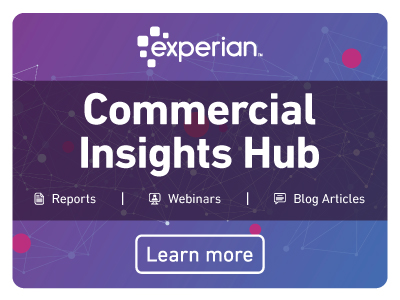Industries
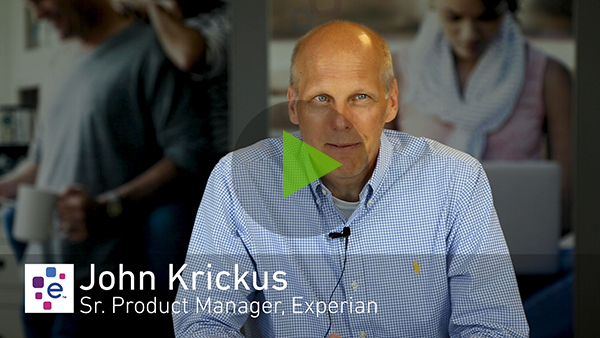
We sat down with John Krickus, Senior Product Manager for Experian's Scoring solutions to ask about the new Social Media Insight, and how this data and score are being used to help businesses strengthen scoring models, and create opportunities for emerging small businesses with limited credit history but strong social media profiles. What is Social Media Insight? We're very excited to bring what we consider a breakthrough capability. Social Media Insight is an expansion, a use of new information beyond traditional credit data, that both improves the performance of our scores, provides attributes to our clients, and is directly sourced from the social media providers - no screen scraping. What type of social media data is used? So the social media data comes from sources that, like with our other data sources, we are not allowed to publicly disclose, but we are focused on business social media sites. So we're not going after consumer social media data, but social media data from business-oriented sites, so that we can better evaluate small and midsize businesses. What steps are taken to prevent artificially boosting the ratings of a business? So that's a question that we often receive about artificially boosting ratings. We work with social media companies, they have many techniques to identify where the reviews are coming from and to prevent someone gaming the system. Is it 100 percent full proof? No, but it is very effective. How effective has social media data been in predicting risk? As we've seen with using the data in our scoring solutions, we've seen a tremendous boost in score performance. There have been two real gains from using social media data. First is, we've developed about 70 social media attributes. We can now include those attributes and make these attributes available to our clients to improve the performance of risk scores. The second area really devolved from client feedback as we piloted the data. They indicated to us that there were social media data elements that are very helpful. So, we've been able to attain information such as pricing, parking situation, hours of operation, and those additional data elements have also helped our clients in improving their risk performance scores. What type of data do our clients get with Social Media Insight? We're able to provide our clients one of three types of data. First, we can provide a social media IntelliScore. That's our normal IntelliScore with commercial data, and now social media data. So, you get a higher performance. We've boosted performance by 37 percent with our IntelliScore. Second, we can provide those same social media attributes to our clients. So, they can incorporate those social media attributes into their scoring models. And third, we have the descriptive data. I mentioned hours of operation for example, social media data also provides a better description of the business. So, you just don't get an Exercise Gym, you get whether that gym is kickboxing or whether that's just exercise equipment. Can I target specific kinds of businesses? Can it be used for Marketing? We do have the ability to use social media data for identifying better businesses to do business with. Our initial focus though is in developing the attributes and the score for risk management. So that's really the focus for this first phase of Social Media Insight. How might Social Media Insight help an Insurance company? Insurance companies have been very anxious for this data, and they're getting a different view of the business. We're going beyond traditional trade, public record, background information, and now we're able to provide a view of how long has that business been rated? How are the ratings? What's the trend in the number of ratings? So, it's not just your level rating, but are you getting reviews over time? All that information provides a really unique view of the business that we've never seen before. How can Experian clients access Social Media Insight? Our clients can access the data one of two ways. We can provide a batch file. So, if you have a portfolio and you want to add social media attributes and a social media score to that you can provide us a file in batch. We also have our new API access, and we're very excited about that. So that allows you online real-time access to obtain the social media insight data, and it's very easy to program to. Can Social Media Insight help emerging businesses gain access to capital? Yeah that's an excellent area for Social Media Insight. It's really the newer smaller businesses that don't have a very deep credit history, that Social Media Insight now provides a view that previously it may have lacked information, therefore, credit may not have been extended. Now by having a social media site data available. We're adding depth of information to that business. We've actually found that businesses with social media data, as a group, are less risky than businesses without. How does Social Media Insight help improve risk model performance? So, the view that the social media data provides, we have found has boosted model performance, more than doubling model performance for those new emerging businesses. But even for established businesses we've seen double-digit gains in the measure of performance for models such as KS, and again you're getting a view of a business, number of reviews, and we normalized that. So, if you're in an area that's very active with social media data we take that into account. So, if you have 10 reviews in your history, which are in a very active area, you may not get as much of a positive as if you had 10 reviews and a less active social media area. So that combination really boosts performance and predictiveness of the data. How do Social Media Insight help our clients reduce risk? And really that's been one of the biggest breakthroughs with the social media data. Is by being able to boost the performance as I discussed earlier on KS, those new to the world businesses. They now are able to more confidently make decisions in their portfolio, because there is now a wealth of information. They're able to improve their models with this new additional information and have a very good performance improvement with it before and after. So, there's an across the board performance improvement. How does Social Media Insight help to automate the decisioning process? When you have an automated system, you want to have a higher level of confidence. The higher level of confidence you have, the stronger you can, for example, having automatic approve and automatic reject areas. By adding social media data we're able to get a stronger KS performance, which means you have more confidence in the models, and you can now increase the percentage your portfolios that you're putting through either automated or highly automated decision making. It's a significant boost in performance however you cut it. We're very excited about this unique new information source. Social media data is totally different from any other business credit information that's available, and when it's utilized in a model, in a decisioning system, the gain in performance are dramatic, and we're very excited to bring this capability to our clients. Learn about Social Media Insight
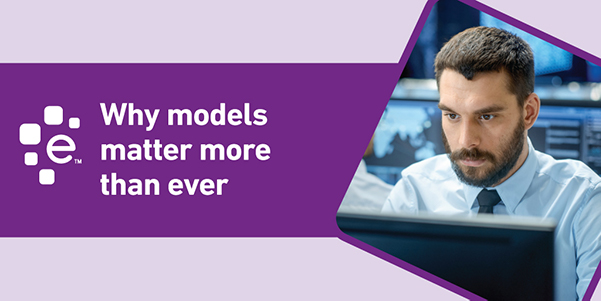
Are the credit models you are using to make lending decisions more than 2 or 3 years old? If so, you are likely making less than optimal credit decisions. You may be turning down a customer who is a good risk — while taking on customers who are more apt to default on their obligations. Every year a model isn’t updated, its accuracy decreases. The economy changes. The consumer’s or business’s financial situation changes. Updating your models, using the most current data and attributes available, you can have confidence that you are making good credit decisions. To make the most accurate credit decisions possible, many businesses are now turning to data-driven decisioning models that are powered by artificial intelligence (AI) within machine learning engines. While the standard regression model works well in some industries, the lift in predictive value from using AI data models can be very important in other industries, such as retail, fraud and marketing. These models use sophisticated algorithms to predict the customer’s future ability to repay their obligation, which means a much more accurate decision than traditional models. Starting with High Quality Data While data has always been at the core of credit decisions, models using machine learning are even more dependent on data. These models can be very accurate, but their accuracy depends on having the necessary data to understand what happened in the past and present behavior to make a prediction for what will happen in the future. The more data provided, the higher the accuracy of the decision. Here are three things to consider when building your data-driven decisioning model: Clean Data – As innovation spurs business and technology to run faster and more efficient, the quality of the data underneath all of that innovation becomes even more important. Machine learning becomes smarter the more data it consumes. This means the accuracy of the credit decisions made by the model is largely dependent on the quality of the data provided. Data from third-party sources often contains mistakes, missing fields, and duplicate information, which results in less accurate credit decisions. Correct Data Points – The accuracy of the results depends on considering the right criteria in the form of data points in the model. When you use machine learning and AI algorithms, they can predict which specific data points will help increase the performance of the model for the specific customer and the specific type of credit decision. Often, data points that you may not consider are the ones that can make a big impact on the accuracy of the decision. Real-Time Data – In the past, there was often significant lag time between collecting and being able to use the data. By using real-time data with machine learning models, you can get a clear picture of the most current view possible and see changes in the different data points as they occur. This lets you make a much more accurate prediction of what will happen, with the consumer or business, than was previously possible with a traditional credit decisioning process. Using Alternative Data to Get the Full Picture Often, additional data — typically referred to as alternative data — that is not readily available from traditional data providers is used to enhance the accuracy and predictive ability of a model. While the model can seem complete without this information, the model may provide suboptimal results without it. Machine learning models can predict the situations and exact type of alternative data a model needs to produce an accurate decision. Experian offers a wide variety of alternative data that clients can use to improve decision models. For example, a business owner may be taking out short-term loans to increase her cash flow, which makes her a much higher credit risk than she appears to be without this data. Weather information is also a common type of alternative data; a business located in Tornado Alley may need higher cash reserves to be a good credit risk. On the other hand, businesses located in an area impacted by a recent weather event, such as a hurricane, may be a good credit risk even with a lower score because both their business and local economy is recovering. Regularly Evaluating Your Data Model You must build in governance and make sure you are evaluating how the model is working on a regular basis, like having an annual checkup with your healthcare providers. Once you begin using a data model, you can’t simply set it and forget it. Ask the following questions to periodically evaluate your models: Are there changes in the outcome of the models? You need to verify that your attributes are still predicting the same outcomes as intended, as well as capturing the same data. For example, say you have an attribute in your model that counts the number of credit lines open for a small business. If the attribute changes and those types of credit lines are no longer reported by the data provider, that number can go from three or four to zero, without there being a change in the number of credit lines open by the business. Because the data that goes into your model has changed, your model is not accurate unless you update the attribute. Is your model stable? You need to make sure that degradation hasn’t reached a point where the predictive value is no longer accurate. For example, scores before the 2008 recession have a different meaning than afterward, due to the changes in the financial system. The future of your business depends on making accurate credit decisions. Instead of using outdated models, use the latest technology and methods available by using machine learning data-driven models. It’s simple. It’s quick. And most importantly, data-driven models are accurate. Related articles: How To Modernize Decisioning with Automation and Real Time Respones Integrating Credit Decisions with the Back Office Improving Customer Experience Through Decisioning as a Service (DaaS)
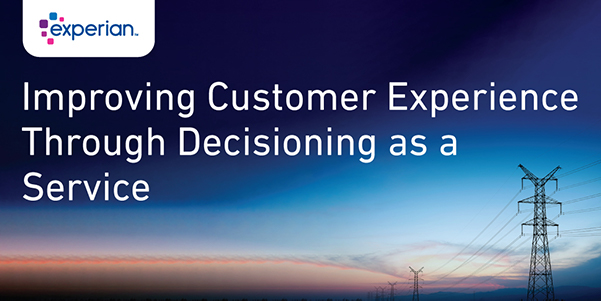
For utility companies, the customer onboarding process can sometimes be a complex, time-consuming, and unpleasant experience, especially if a manual credit decisioning process is in play. Every time a customer interacts with your utility company — be it via the website, telephone, in-person service call, mobile app, or social media — their experience sets the tone for the overarching relationship between the customer and your company. To improve the onboarding experience, many utilities are turning to machine learning to make faster and simpler credit decisions. However, creating a custom machine-learning decisioning engine is complex and can be costly. By leveraging machine-learning capabilities through Decisioning as a Service (DaaS) offerings, utilities can automate the decisioning process and create a frictionless customer experience. For example, a customer applying for service – even with a large utility — can be approved within seconds by an agent using a tablet. Using DaaS to Automate Your Credit Decisions DaaS can be used for many different types of decisioning — prescreening, prequalification, or instant credit. Utilities also use DaaS for authenticating and resolving identities and assisting with the rationalization of deposits. Other uses include improving the customer experience, credit line management, retention, cross-selling and collections optimization. The process is like using traditional decisioning methods where the customer or customer service agent enters the customer’s information into the website or system. The utility system then connects with the DaaS engine through an Application Programming Interface (API), The DaaS engine then aggregates real-time data from the credit bureaus and other data providers about the customer, runs them through business rules — and a decision is rendered. The decisioning engine uses rules and algorithms to create predictive models for credit, fraud and, bankruptcy risk, profitability, retention and other key areas. The DaaS engine then automatically determines the results, such as approval, decline, instant pre-screen, cross-sell, or a collection decision. More than just providing a result, the system helps your utility know exactly how to treat the customer based on their risk level. DaaS also helps utilities by customizing offers that deliver both business value and value to the specific customer. Additionally, the algorithms are continually updated so your decisions are always based on the current business climate, market drivers, and regulatory conditions. Creating a Seamless and Personalized Customer Experience From the customer’s perspective, the process is simple and seamless. Instead of waiting for hours — or possibly days — the customer receives an answer in real-time. If the decision is good news for the customer, they can move on with the process. And if the decision is not what the customer was hoping to hear, they can quickly move on and determine their next steps. There is no waiting, wondering, or anxiety. Using DaaS also creates a more personalized experience for the customer. DaaS recommends the next best step based on the customer’s specific situation, which is an informed way to begin your relationship and sets the right tone for the future. For example, DaaS may recommend no deposit based on risk-level, or a specific product or offer of value to the specific customer. Improving Operational Efficiency and Growing Revenue In addition to more loyal and satisfied customers, your utility company will see operational benefits and lower costs from using DaaS. Your employees no longer need to manually process credit applications and make decisions, thus eliminating paperwork, tasks, and time. Because DaaS provides centralized decision making, you can use the technology across different enterprise frameworks, call center environments, and processing systems. This dramatically increases your efficiency by eliminating manual processes which give your employees more time working to improve the customer experience. Because the process is more accurate than the traditional credit decisioning model, utilities can make better credit decisions. As a result, your utility can significantly reduce bad debt and fraud, which improves your overall financial health. At the same time, you can increase revenue by approving customers who are good credit risks but may have been denied using a manual or out-of-date decisioning model, and thus improve the customer experience. Additionally, your ability to more effectively cross-sell customers will help grow your revenue. Your utility’s success depends on its ability to make quick and accurate credit decisions while also providing a positive customer experience. By using an API to integrate DaaS into your systems, you can have confidence you are making accurate decisions while creating customer loyalty, improving revenue, and reducing costs. It’s simple, it’s easy and your customers will love it.
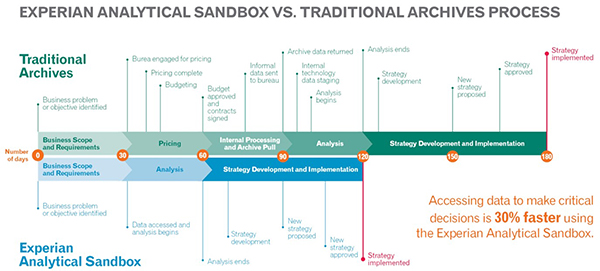
The appetite for businesses incorporating big data is growing significantly as the data universe continues to expand at an astronomical rate. In fact, according to a recent Accenture study, 79% of enterprise executives agree that companies that do not embrace big data will lose their competitive position and could face extinction. Especially for financial institutions that capture and consume an incredible amount of data, the challenge becomes how to make sense of it. How can banks, credit unions, and other lenders use data to innovate? To gain a competitive advantage? This is where analytics sandboxes come in. A sandbox is an innovation playground and every data-consuming organizations’ dream come true. More specifically, it’s a platform where you can easily access and manipulate data, and build predictive models for all kinds of micro and macro-level scenarios. This sounds great, right? Unfortunately, even with the amount of data that surrounds financial services organizations, a surprising number of them aren’t playing in the sandbox today, but they need to be. Here’s why: Infinite actionable insights at your fingertips One of the main reasons lenders need a sandbox environment is because it allows you to analyze and model many decisioning scenarios simultaneously. Analysts can build multiple predictive models that address different aspects of business operations and conduct research and development projects to find answers that drive informed decisions for each case. It’s not uncommon to see a financial services organization use the sandbox to simultaneously: Analyze borrowing trends by type of business to develop prospecting strategies Perform wallet-share and competitive insight analyses to benchmark their position against the market Validate business credit scores to improve risk mitigation strategies Evaluate the propensity to repay and recover when designing collection strategies A sandbox eliminates the need to wait on internal prioritization and funding to dictate which projects to focus on and when. It also enables businesses to stay nimble and run ad-hoc analyses on the fly to support immediate decisions. Speed to decision Data and the rapid pace of innovation make it possible for nimble companies to make fast, accurate decisions. For organizations that struggle with slow decision-making and speed to market, an analytics sandbox can be a game-changer. With all your data sources integrated and accessible via a single point, you won’t need to spend hours trying to break down the data silos for every project. In fact, when compared to the traditional archive data pull, a sandbox can help you get from business problem identification to strategy implementation up to 30% faster, as seen with Experian’s Analytical Sandbox: Cost-effective analytics Building your own internal data archive with effective business intelligence tools can be expensive, time-consuming, and resource-intensive. This leaves many smaller financial services at a disadvantage, but sandboxes are not just for big companies with big budgets. An alternative solution that many are starting to explore is remotely hosted sandboxes. Without having to invest in internal infrastructure, this means fast, data-driven decisions with little to no disruption to normal business, fast onboarding, and no overhead to maintain. For financial institutions capturing and consuming large amounts of data, having an analytical sandbox is a necessity. Not only can you build what you want, when you want to address all types of analyses, you’ll have the insights to support business decisions faster and cheaper too. They prove that effective and efficient problem solving IS possible! Ready to learn more about Experian's Analytical Sandbox and how it can help you optimize your business? Contact Commercial Data Science
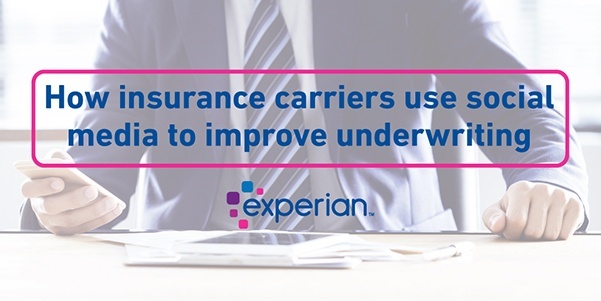
A gastropub restaurant applies for business insurance and is approved. However, social media insights show the restaurant is declining. Even though underwriters usually take a quick look at social media postings, evaluating the trends of the business is not part of the decision process. Costly mistakes: Underwriting using only business supplied information How could something as basic as a business in decline be overlooked in the insurance underwriting process? Think about the process when reviewing a new business insurance application. The underwriter reviews the application and looks at traditional credit and public filing information. Although the underwriter checks out the company website, he doesn’t meet or interact with the company. He then must make a potentially costly business decision about its risk level. Even though the process appears thorough, it does not use the new wealth of information available. How social media provides information about business health If the insurance company had used unique and new sources of social media data, the underwriter would have seen a different picture of the restaurant. The trends in the number of reviews point to a declining business due to poor service, bland food, or increased competition. Traditional data sources miss these subtle signs that point to a higher risk of going out of business. While one poor review shouldn’t result in a denial, a pattern of a declining business is important. This can be spotted using tools that analyze the trends in reviews and ratings for the business line. After all you cannot compare restaurants, with high volumes of social media postings, with say a dry cleaner. By correctly using social media data during the underwriting process, insurers can give an additional lift on the model to determine the risk. Social media data can also help determine more information about the business. For example, an exercise gym may have treadmills and weight machines, or it might actually be a kickboxing studio, which has a much higher level of risk and premiums. Underwriters also get a much more granular view than a typical application, such as the parking situation and the hours. Because risk is higher for businesses with a liquor license, insurers can often learn if a bar didn’t disclose this on their application. Customer photos also often tell a story not detectable on the application, such as broken stairs or a fireplace without proper screens. Using artificial intelligence to analyze social media data Looking through social media for each application takes large amounts of time. Even more importantly, humans may be subject to bias and miss word patterns in reviews. By using an artificial intelligence tool with machine learning capability to analyze social media data for business insurance applications, underwriters can gain a much more accurate picture of the risk they are assuming by insuring a business. Additionally, an AI tool can analyze business health much more quickly than an underwriter could doing the social media check manually. Insurance companies that use artificial intelligence tools to analyze social media data during the underwriting process can more accurately predict the risk of a business. Because the processing speed, adding this additional step does not slow the process down. By reviewing what other people are saying about the business, your insurance company can decrease risk and save money on claims.
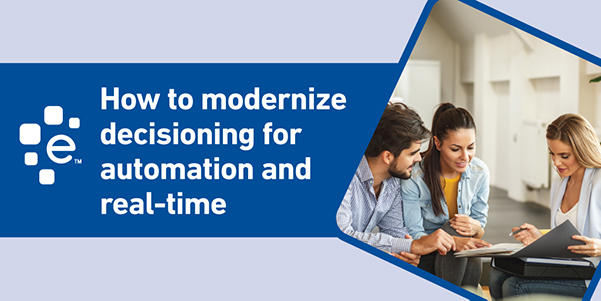
When a new customer wants to establish credit terms with you, the first thing they’re asked to do is fill out your credit application. When you hand over a paper application, did you know you could be negatively impacting your revenue or creating a poor customer experience? Some companies don’t. More than likely, your customer has filled out at least one digital application in the past. The initial perception your application says about your company is that you’re out of step with technology — which may lead them to wonder where else you may be lagging behind. Digital applications provide a simplicity factor, and by not offering one, your credit approval process is perceived to be more difficult, leaving the customer with more work to do —spending extra time writing their information by hand and returning the application — either by email, fax, or in person. Because many companies have already moved to a digital application, your pen-and-paper process sticks out to the customer — and not in a good way. Not to mention, manually processing a paper application takes longer — often much longer — than a digital application. This means customers leave without a credit approval, giving them time to change their mind about their purchase or find a better deal — meaning you just lost a new sale. And even if they still choose to work with you, their relationship with your company starts out with a less-than-amazing customer experience. After the paper application is completed, the workflow process is often time-consuming, error-prone, and cumbersome. The time involved also means that your company waits longer to receive revenue from the sale. By using a manual process, your team spends hours on processing and decisions that could be better spent directly servicing customers or working on other initiatives to grow business. DecisionIQ from Experian automates consistent real-time decisions, streamlining your entire process from applications to onboarding.
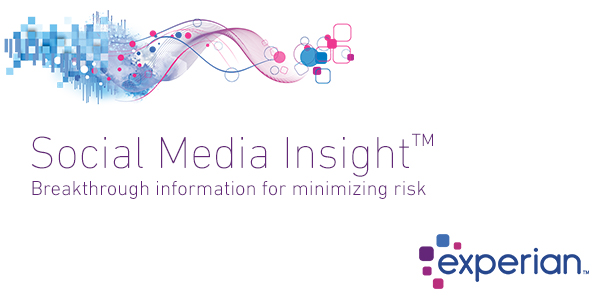
For lenders, alternative data can be the factor in edging out your competitors, especially when better decisions are needed to compete for emerging businesses and startups. Both startups and emerging businesses may represent a good growth opportunity, but they may also be high risk. The challenge? Businesses with thin credit profiles can be difficult to score. Social Media Insight TM provides lenders with another layer of data that can help you better assess the direction of these businesses, score them more accurately and open new growth opportunities. After all, nobody likes to leave money on the table. For emerging businesses who have a thin credit profile but have a strong social media reputation, Social Media Insight can be a factor in gaining access to credit and resources they deserve. Social Media Insight enables you to see the activity, trends and sentiment on a business, over time. In our Experian DataLab tests, we improved overall model performance by 12 percent and new and emerging businesses by 91 percent, boosting predictive performance over traditional data sets. Social Media Insight is directly sourced data providing you with over 70 attributes including trends and sentiment along with descriptive attributes. This powerful data enables you to more accurately score or assess new and emerging business as well as long established accounts. Want to learn more? Watch our on-demand webinar or contact your Experian representative today.
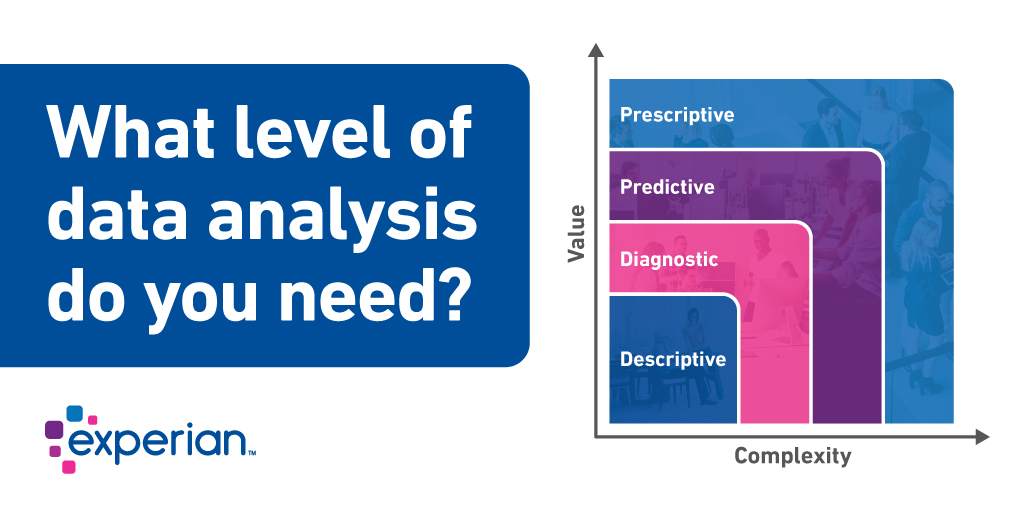
Data analysis surrounding lending practices for commercial lenders falls into 4 distinct buckets that define scope, usability, and purpose. In this post we will discuss how they differ in terms of value and complexity. Descriptive Analytics Descriptive analytics provide the current state of a commercial lender’s acquisitions, portfolio, or other parts of the lending lifecycle. This is “Reporting” in its simplest form. Defining and creating metrics can be as simple as a snapshot of the firmographic and performance elements of a portfolio to complex retro trends that define the effectiveness and success of a lender. Full coverage of the target market and accurate data play a big part in the success of this type of analysis. Selecting the wrong element, when creating a view, can lead the lender to a sub-optimal understanding of the state of their business. Looking at a competitor’s metrics can inform market share and pricing decisions. Experian commercial clients use Portfolio Benchmarking reports as an empirical view into the health of their business compared to their market peers. Adding data visualization on top of the descriptive-analytic reporting quickly closes the gap to a diagnosis. In the map below Texas, California, and Florida have higher rates of account opening and would be attractive target regions for acquisition. Diagnostic Analytics A Diagnostic view of lending performance will look at the portfolio health of a lender and its peers and determine what are the key success and opportunity drivers within comparable products. Larger financial institutions have been performing this type of analysis for years. Several years ago, fintech lending hit its stride challenging the large commercial lenders by providing targeted products in niche lending spaces with little or no traditional commercial credit data. Large commercial lenders used benchmarking and market analysis to understand where the fintechs were being successful. Large lenders use of alternative data sources and market intelligence helped them to recognize the gaps in identifying and evaluating the risk of those underserved businesses. Fintech use diagnostic analysis, to their advantage, to make fast decisions and pivot to market demand. In the chart above, you can see that ABC bank is able to identify where they are offering higher credit limits than their competitors. This client had similar bad rates to its peers causing the lender to have higher losses due to improperly assigned credit limits. Predictive Analytics Predictive analytics can help to scope the effectiveness of a strategic decision and plan for the long-term impacts of credit decisions. Financial institution use this type of analysis to forecast loan performance and plan for impacts to cash flow as economic and market conditions change. Machine learning is used in predictive analysis to be nimbler in the evaluation of vast amounts of data to provide more accurate prediction of future outcomes. Large financial institutions will use Machine Learning in predicting response to an offer through the lifecycle to the collection of outstanding debt. Prescriptive Analytics Predicting potential outcomes within a commercial lender’s strategies only gets them half way to a successful outcome. Providing insight on top of the analytic content is what drives the decisions to stay the course or pivot to an alternate course of action. Prescriptive analytics provides that direction. Machine learning can be used as a tool in prescriptive analytic engagements to develop models that can learn and pivot with changes to the market and behaviors of businesses within that market. Having the capability to adjust actions associated with outcomes allows the model to stay relevant and predictive over a longer period. As customer experience drives lending practices, commercial lenders look to use varying levels of analysis as stepping stones to better serve their small business clients. Got a question about analytics? We would be delighted to answer your questions. Commercial Data Science
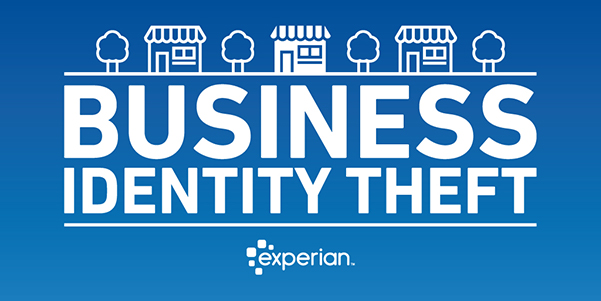
You likely go to great lengths to protect your own identity from fraud and theft. But are you actively protecting your business’s identity as well? Even more importantly, do you make sure you are not doing business with fraudulent companies that have been victims of identity theft themselves? In many ways it’s harder to protect your business identity than your consumer identity. Information about most businesses is publicly available – and as easy to find as a simple Google search. Because businesses self-report much of their own information, it’s easy for a thief to add their name or address to a company. To make it even easier, many businesses do not protect their EIN the same way as they secure their SSN – which they should. At first glance, you may think having your personal identity stolen to be more damaging than a business identity. But in fact, the opposite is often true. Business owners often personally guarantee loans, even if the loan turns out to be fraudulent. And then if a business must close its doors due to the losses from the theft, the business owner now has no income and must repay the loan. How Business Identity Theft Happens Some thieves steal business identities by purchasing a shell corporation. Others take over a company’s data. But regardless of how the left happens, the criminals often go to great lengths to mirror the company. Some even rent space in the same building as the original company and using the same suppliers. At this point, the fraudulent company can start physically intercepting deliveries as well as applying for loans and credit, posing as the original company. Criminals start with one piece of information that is real, such as an address or EIN number. And then start operating as if they are the company and changing the data. Criminals often wait patiently while building up their reputation and credit history, then “bust out” with a large amount of fraudulent activity in a short period of time, and then walk away before they are discovered. Protect Your Own Business Identity Business owners must constantly monitor their business information to spot red flags that criminals have taken over. The earlier the theft is discovered, the less damage that occurs. Here are three things to look for to spot business identity theft of your own business: Look for new addresses added. Check your credit reports and government filings to verify the address. One of the first signs of theft is often a new address added to your business information. Verify that new registered owners have not been added. Thieves will often add a new principal — CEO, owner or partner — to the list of owners. The criminals can then conduct business as if they are an owner. Check business accounts daily. Use online banking — which also reduces the risk of stolen paper statements — to look for any transactions that you or your employees did not make. Consider setting mobile alerts for suspicious transactions to spot issues even faster. Verify Your Customers are Not Fraudulent Companies Before doing business with a company, do a business verification by making sure the company is who they say they are and not a and not a fraudulent company. Since verifications cost time and money, take each customer on a case-by-case basis regarding how deep to dig. If a customer orders $100,000 worth of computer equipment, you should do a more thorough investigation than for a business ordering a single $500 laptop. However, anytime you are extending a line of credit to a company, you should deep dive into a companies' history and data because you are taking on a high risk. Stacking loans is a common tactic – meaning companies take loans from multiple companies at the same time. Because many companies often verify customers by looking at their relationship with the business, they are verifying in a vacuum instead of seeing the entire picture. By using databases and tools that provide a holistic view of all activity, it becomes much easier to find the fraud. Here are five things to look for when verifying a company: Verify the EIN number. One scheme is to use a different EIN number and have all other pieces of information the same. Make sure the company you are doing business with is using the same EIN number as the legitimate company. Consider the number of open lines of credit. Because fraudulent companies often open multiple lines of credit at the same time, determine the current amount of open credit. Multiple large lines opened around the same time can be a red flag. Look at the number of sub-companies and activity between the companies. Criminals often set up a fraud ring by operating as sub companies underneath a single company. The “companies” then loan money to each other to boost credit scores and credibility. Note for periods of dormancy. When a business identity is first stolen, the criminals set up the company and then go dormant to build credibility through age. The company will then “bust out” by making a lot of transactions very quickly with multiple companies. Look for additional addresses. Check to see if the address you have been given is the same as the company’s headquarters. Multiple similar addresses can be a red flag. As business identity theft continues to rise, you must keep your eyes open for signs of theft — both with customers and your own business. A single credit check or google search simply isn’t enough. You owe it to your business and your future.
